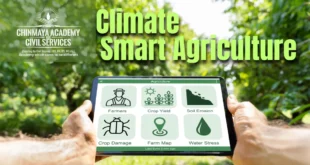What is COP The way the world organises its collective response to the global challenge of climate change is through Conferences of the Parties (COPs). At the 1992 Rio de Janeiro Earth Summit, world leaders came together to establish the United Nations Framework Convention on Climate Change (UNFCCC). In order …
Read More »Green Credit Program-UPSC
The innovative market-based Green Credit Program (GCP), announced on October 13, 2023, is intended to encourage voluntary environmental actions by a range of stakeholders, including individuals, communities, businesses, and private sector industries, across diverse sectors. The Indian Council of Forestry Research and Education (ICFRE) acts as the GCP Administrator, in …
Read More »The Silkyara Tunnel Collapse Occurred on November 12
The Silkyara tunnel collapse occurred on November 12, 2023, when a portion of the under-construction Silkyara Bend – Barkot tunnel collapsed in the Uttarkashi district of Uttarakhand, India. Incident On November 12, 2023, a portion of the under-construction Silkyara Bend – Barkot tunnel collapsed in the Uttarkashi district of Uttarakhand, India. The collapse …
Read More »Biofuels in India
Any hydrocarbon fuel that is produced from an organic matter within a short period of time is considered a biofuel. It may be solid, liquid or gaseous in nature. Solid: Wood, dried plant material, and manure Liquid: Bioethanol and Biodiesel Gaseous: Biogas Generations of biofuel First generation Sourced from food-based …
Read More »Climate-Smart Agriculture
A strategy known as “Climate-Smart Agriculture” (CSA) aids in directing efforts to change agri-food systems towards environmentally friendly and climate-resilient methods. CSA is in favour of achieving globally recognised objectives like the SDGs and the Paris Agreement. The three main objectives of CSA Sustainably increase agricultural productivity and incomes: This …
Read More »Air Pollution and Delhi Government
Air pollution in Delhi is a major environmental and health concern. The city’s air quality is consistently among the worst in the world, and it is estimated that air pollution causes over 20,000 premature deaths in Delhi each year. There are a number of factors that contribute to air pollution …
Read More »Earth Summit
The Earth Summit, often referred to as the United Nations Conference on Environment and Development (UNCED), took place in Rio de Janeiro, Brazil, from June 3–14, 1992. This international conference brought together political leaders, diplomats, scientists, media representatives, and non-governmental organisations (NGOs) from 179 countries in an attempt to focus …
Read More »Biosphere Reserve
Biodiversity refers to the variety of living species on Earth, including plants, animals, bacteria, and fungi. While Earth’s biodiversity is so rich that many species have yet to be discovered, many species are being threatened with extinction due to human activities, putting the Earth’s magnificent biodiversity at risk. Biosphere …
Read More »Air Pollution
India is the world’s second most polluted country. Fine particulate air pollution (PM2.5) in comparison to WHO guidelines shortens an average Indian’s life expectancy by 5.3 years. Records show that in 2019 over 1.6 million deaths were attributed to poor air quality. This ranged from strokes, diabetes, lung cancer and …
Read More »CHEETAH PROJECT TO BRING IN 12 BIG CATS FROM SOUTH AFRICA
India and South Africa have finally signed a long-pending agreement to translocate 12 cheetahs to India, the Environment Ministry said in a statement on Friday. The cheetahs will be transported to India by February-end and reintroduced at the Kuno National Park in Madhya Pradesh, where eight such cats were brought …
Read More » Chinmaya IAS Academy – Current Affairs Chinmaya IAS Academy – Current Affairs
Chinmaya IAS Academy – Current Affairs Chinmaya IAS Academy – Current Affairs








